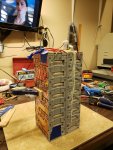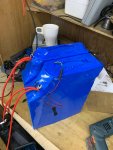As I couldn't get an alta at reasonable money and having been informed the races will be an hour long I decided rather than buy a mountain bike suspended e bike I'd get someone to build one.. So far we have an 08 450 crf chassis mounted a qs 30kw motor and built 2 battery packs of 210 Samsung qs6 cells giving 60ah using a bacs 8000 controller.. We started with a motenergy motor but couldn't get numbers we wanted, guy mentioned haul sensors or some such being one of the issues so we are using the qs direct drive with 10 front 70 rear sprockets I'll post pics of build so far when I've transfered to file
You are using an out of date browser. It may not display this or other websites correctly.
You should upgrade or use an alternative browser.
You should upgrade or use an alternative browser.
I'm building a bike to race the series as I couldn't get an alta at a fair price. Details of build
- Thread starter lambo
- Start date
DonCox
Well-known member
- Likes
- 616
- Location
- Lake Havasu City, AZ
It is always really neat to see others doing there own builds, and I always learn from every one. My build is on this forum too, "A little bit about my 2008 Yamaha YZ250F". But I have a few questions about your build. I know you are going to post more info soon, but what motor are you using? The QS 138 90H? I know others are using this motor, or is there a bigger one from QS?
I built my own battery packs (I have 3 packs in my bike) with 20S7P Sony cells VTC6, and get about 84V peak, and ~200A out of each pack. What is your cell configuration and the actual cells. I am trying to figure your configuration. I'm always looking for a better cell, and the VTC6 are good but they are going up as fast as inflation...
My bike runs pretty good, but I am frustrated with the controller( I am using a Kelly KLS72701). A friend is getting a ASI BAC8000 and we are going to test it on my bike to see how it compares.
Keep the info coming I am interested.
Seems like anyone with a cheap China spot welder is making their own battery packs these days. Although I applaud and respect anyone with the fortitude to DIY, I'm seeing some very unsafe designs. I'm talking 18650 style packs now, prismatic and pouches are another ballgame.
Now I'll admit, there's certain design details that one can't ascertain just by looking at a few build pictures. However, those details are some of the most critical.
For example, one could argue all day about the pros/cons of series/parallel vs parallel/series, fuse or not fuse, continuous cell sidewall support or not, cell to cell contact or separation, thermal conduction vs isolation, etc. The answers are design decisions that can easily be seen just looking at a few basic build pictures.
The typical "unseen" detail I'm referring to have to do with basic structural integrity of the cell module and the module to the pack. Starting with those little "clip together" cell holders. They're great for small format modules, but will flex quite a bit when put under the stress of dozens of 18650 cells. This can overstress the busbar/interconnect spot-welds leading to possible short circuits. Absolute worse case is those modules that simply "hot glue" the cells to themselves, that's it! An accident waiting to happen. However, you can get the absolute maximum cell density that way, lol.
Anther typically missing detail is how the builder secures this array of individual clip holders to some load bearing structural support like a cold plate or even the main pack housing itself. Frankly, I've never seen anyone show this little design detail for whatever reason. Usually the next pictorial shot shows the module all nice and shrink wrapped together using gigantic shrink wrap. Which begs the question further . . . . how are these shrink wrapped modules being secured to the pack. Are there hidden screws, studs, or other type of fastener? I suspect that the answer is NO more often than not. These mummified cell modules must be literally "slip fit" into an enclosure (typically the main pack housing but sometimes a sub housing) using foam or an elastomer to keep things from moving around. Again, the lack of any fixed and structurally sound load path can lead to unwanted cell movements and overstress the interconnects.
Next, how is/are the module/pack enclosure(s) designed? This is more engineering 101. What materials are used and is IT structurally sound?
Finally, how does the pack/module assy attach to the frame? Will it withstand a major get off, etc?
Bottom line, although there's no such thing as a perfectly "safe" battery pack, there's some really good battery pack design engineering going on in the DIY arena. There's some really poor (dangerous) stuff as well.
Now I'll admit, there's certain design details that one can't ascertain just by looking at a few build pictures. However, those details are some of the most critical.
For example, one could argue all day about the pros/cons of series/parallel vs parallel/series, fuse or not fuse, continuous cell sidewall support or not, cell to cell contact or separation, thermal conduction vs isolation, etc. The answers are design decisions that can easily be seen just looking at a few basic build pictures.
The typical "unseen" detail I'm referring to have to do with basic structural integrity of the cell module and the module to the pack. Starting with those little "clip together" cell holders. They're great for small format modules, but will flex quite a bit when put under the stress of dozens of 18650 cells. This can overstress the busbar/interconnect spot-welds leading to possible short circuits. Absolute worse case is those modules that simply "hot glue" the cells to themselves, that's it! An accident waiting to happen. However, you can get the absolute maximum cell density that way, lol.
Anther typically missing detail is how the builder secures this array of individual clip holders to some load bearing structural support like a cold plate or even the main pack housing itself. Frankly, I've never seen anyone show this little design detail for whatever reason. Usually the next pictorial shot shows the module all nice and shrink wrapped together using gigantic shrink wrap. Which begs the question further . . . . how are these shrink wrapped modules being secured to the pack. Are there hidden screws, studs, or other type of fastener? I suspect that the answer is NO more often than not. These mummified cell modules must be literally "slip fit" into an enclosure (typically the main pack housing but sometimes a sub housing) using foam or an elastomer to keep things from moving around. Again, the lack of any fixed and structurally sound load path can lead to unwanted cell movements and overstress the interconnects.
Next, how is/are the module/pack enclosure(s) designed? This is more engineering 101. What materials are used and is IT structurally sound?
Finally, how does the pack/module assy attach to the frame? Will it withstand a major get off, etc?
Bottom line, although there's no such thing as a perfectly "safe" battery pack, there's some really good battery pack design engineering going on in the DIY arena. There's some really poor (dangerous) stuff as well.
It is always really neat to see others doing there own builds, and I always learn from every one. My build is on this forum too, "A little bit about my 2008 Yamaha YZ250F". But I have a few questions about your build. I know you are going to post more info soon, but what motor are you using? The QS 138 90H? I know others are using this motor, or is there a bigger one from QS?
I built my own battery packs (I have 3 packs in my bike) with 20S7P Sony cells VTC6, and get about 84V peak, and ~200A out of each pack. What is your cell configuration and the actual cells. I am trying to figure your configuration. I'm always looking for a better cell, and the VTC6 are good but they are going up as fast as inflation...
My bike runs pretty good, but I am frustrated with the controller( I am using a Kelly KLS72701). A friend is getting a ASI BAC8000 and we are going to test it on my bike to see how it compares.
Keep the info coming I am interested.

You can probably see from the latest pic the motor I'm using.. The battery questions I'll answer along with the next post if that's okIt is always really neat to see others doing there own builds, and I always learn from every one. My build is on this forum too, "A little bit about my 2008 Yamaha YZ250F". But I have a few questions about your build. I know you are going to post more info soon, but what motor are you using? The QS 138 90H? I know others are using this motor, or is there a bigger one from QS?
I built my own battery packs (I have 3 packs in my bike) with 20S7P Sony cells VTC6, and get about 84V peak, and ~200A out of each pack. What is your cell configuration and the actual cells. I am trying to figure your configuration. I'm always looking for a better cell, and the VTC6 are good but they are going up as fast as inflation...
My bike runs pretty good, but I am frustrated with the controller( I am using a Kelly KLS72701). A friend is getting a ASI BAC8000 and we are going to test it on my bike to see how it compares.
Keep the info coming I am interested.
The battery pack is being made for me as I do not have the knowledge to build one I did not go into this without doing research first. I've raced and ridden off road for 40 years and have ample mechanical. Knowledge but the electronics I left to those with the knowledge.. As I'm staff at the club hosting the e bike series I have been in contact with a lot of the dealers and bike builders so when I made the decision to build my own I asked a couple of the guys that are established e bike dealers and was put onto a company that manufacture batteries and one of them put me in touch with a guy who does work for them on the custom pack side of things. The reason the pics are of shrink wrapped packs is because that's what I got. It seems guys doing this kind of work are not that keen to share thier processes.. Though he has been prepared to Warrentee his work
Dain_SSE
Active member
- Likes
- 31
- Location
- Cedar Falls, IA
What is the torque constant on that QS motor? The ME1304 I run on the YZ450A is around .13Nm/A - it is barely enough with a 10/66.
DonCox
Well-known member
- Likes
- 616
- Location
- Lake Havasu City, AZ
Have you seen the RMZ build on this forum by Riverin Electric RMZ
He is using the QS motor and controlling it with a BAC8000. At 72V 450A he estimates about 32.5KW, or about 40hp. That is MAP3 on an Alta. But You have to have the battery pack that will supply 450A. QS also has a smaller motor with a Gear Reduction built on. It would be great if they had a gear reduction QS 138 90H model.
Yes on what type cells and the packaging info, e.g. 20S7P I couldn't find a QS6 Samsung cell. The Samsung 20S cell gives 30A.
I am trying to get the performance of an Alta, but I'm not there yet. I think I have a good enough motor, and enough Amperage at 72V but I am not happy with my controller. My friend I ride with, has Alta's. so I can see the difference. Plus the controller drops out at peak need, for a second or two. and comes back. No good for moto track... I cannot eliminate the dropout without really lowering the power out. Kelly does not have error logging. It reports an error if you look at it when it happens. but it is hard to see when your on the track, when it fails.
He is using the QS motor and controlling it with a BAC8000. At 72V 450A he estimates about 32.5KW, or about 40hp. That is MAP3 on an Alta. But You have to have the battery pack that will supply 450A. QS also has a smaller motor with a Gear Reduction built on. It would be great if they had a gear reduction QS 138 90H model.
Yes on what type cells and the packaging info, e.g. 20S7P I couldn't find a QS6 Samsung cell. The Samsung 20S cell gives 30A.
I am trying to get the performance of an Alta, but I'm not there yet. I think I have a good enough motor, and enough Amperage at 72V but I am not happy with my controller. My friend I ride with, has Alta's. so I can see the difference. Plus the controller drops out at peak need, for a second or two. and comes back. No good for moto track... I cannot eliminate the dropout without really lowering the power out. Kelly does not have error logging. It reports an error if you look at it when it happens. but it is hard to see when your on the track, when it fails.
chrisflysit
Member
- Likes
- 20
- Location
- 78626
Seems like anyone with a cheap China spot welder is making their own battery packs these days. Although I applaud and respect anyone with the fortitude to DIY, I'm seeing some very unsafe designs. I'm talking 18650 style packs now, prismatic and pouches are another ballgame.
Now I'll admit, there's certain design details that one can't ascertain just by looking at a few build pictures. However, those details are some of the most critical.
For example, one could argue all day about the pros/cons of series/parallel vs parallel/series, fuse or not fuse, continuous cell sidewall support or not, cell to cell contact or separation, thermal conduction vs isolation, etc. The answers are design decisions that can easily be seen just looking at a few basic build pictures.
The typical "unseen" detail I'm referring to have to do with basic structural integrity of the cell module and the module to the pack. Starting with those little "clip together" cell holders. They're great for small format modules, but will flex quite a bit when put under the stress of dozens of 18650 cells. This can overstress the busbar/interconnect spot-welds leading to possible short circuits. Absolute worse case is those modules that simply "hot glue" the cells to themselves, that's it! An accident waiting to happen. However, you can get the absolute maximum cell density that way, lol.
Anther typically missing detail is how the builder secures this array of individual clip holders to some load bearing structural support like a cold plate or even the main pack housing itself. Frankly, I've never seen anyone show this little design detail for whatever reason. Usually the next pictorial shot shows the module all nice and shrink wrapped together using gigantic shrink wrap. Which begs the question further . . . . how are these shrink wrapped modules being secured to the pack. Are there hidden screws, studs, or other type of fastener? I suspect that the answer is NO more often than not. These mummified cell modules must be literally "slip fit" into an enclosure (typically the main pack housing but sometimes a sub housing) using foam or an elastomer to keep things from moving around. Again, the lack of any fixed and structurally sound load path can lead to unwanted cell movements and overstress the interconnects.
Next, how is/are the module/pack enclosure(s) designed? This is more engineering 101. What materials are used and is IT structurally sound?
Finally, how does the pack/module assy attach to the frame? Will it withstand a major get off, etc?
Bottom line, although there's no such thing as a perfectly "safe" battery pack, there's some really good battery pack design engineering going on in the DIY arena. There's some really poor (dangerous) stuff as well.
I wonder the same thing. I tried to address those issues with my battery build for the Sur-Ron and will carry this knowledge on to the build for my CRF250R conversion. See my build here with battery details. 2017 Honda CR250R to Electric - Endless Sphere

Unfortunately that's not something I can answer.. I've come at this as a rider and asked people to build my bike as I don't have the electronics know howWhat is the torque constant on that QS motor? The ME1304 I run on the YZ450A is around .13Nm/A - it is barely enough with a 10/66.
DonCox
Well-known member
- Likes
- 616
- Location
- Lake Havasu City, AZ
Dain, I think this might answer your question, by doing some reverse mathematics. Here are the spec sheets on the ME1302, and ME1304, and calculations on the info that QS gives for their motor, the QS138 90H.What is the torque constant on that QS motor? The ME1304 I run on the YZ450A is around .13Nm/A - it is barely enough with a 10/66.
On the 1302 you can see the torque constant is derived from 100Nm divided by the peak amps, 660 =.15Nm/A
On the 1304 you can see the torque constant is 75Nm divided by peak amps 620=12Nm/A
On the QS138 90H the torque constant is there, but a little different. 200A is max torque, but it says you can do 2 times the rated power or 400A for 80Nm=.20, it also says you can go 3 times to reach overload??? What does that mean.
But you can see people all over running this QS motor at 450A, so it can handle it, but will it overheat. (Maybe not in Canada in the winter, but here in the desert, mine is already running hotter at 85 degrees F). It also says the windings can withstand 150C temp???
My ME1302 gets up to 56C and I thought that was hot, without the water cooling system on. I am now installing the water system. Can we run the ME motor harder and hotter than the spec, or does any one know? Have you, Dain, looked at your motor temp after a hard run. You are running your motor at 100V 450A, can you pump 550A out of your controller, the motor is rated at 620A?



Dain_SSE
Active member
- Likes
- 31
- Location
- Cedar Falls, IA
I don't have any way to check temp at the thermistor aside from hook it up to dvt... but after only a few minutes riding a sandy track in the manor I like to ride (WOT) - its definitely hot. I see lots of videos too of people with the 90H, but they are only ever short clips. I've noticed in electric conversions people exaggerate their run time and performance to a level that is almost hilarious. I try to cut through the BS and misinformation whenever I can! My conclusion with the ME1304 is it needs a much higher reduction than I'm setup to run, and even with that I don't think it's enough motor. I'm planning to change motor and go to a 2170 pack soon.
Mines alive its running 600amps it topped out at 75mph and seems to be running well.. Very quick by all accounts.. This is the builder in the vid and this run was literally done before it had its first charge just to test it and it ran out at 72.5 just as clip ends of course it charges to 84.
Jayfox911
Well-known member
- Likes
- 182
- Location
- San Diego, CA
You have to upload to YouTube or Vimeo then post the link to the video.Won't post the vid saying something about not having extension permission
Similar threads
- Replies
- 2
- Views
- 1,941


